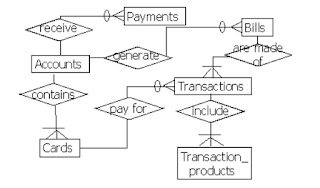SDLC - Software Development Life Cycle Important Question Answer for IGNOU BCA MCA Students and other IT Students
What is Software Development Life Cycle? (SDLC)
System Development Life Cycle (SDLC) is the overall process of developing information
systems through a multi-step process from investigation of initial requirements through
analysis, design, implementation and maintenance.
Draw a diagram for pure waterfall life cycle.
Phase I – Modeling Phase
In this phase we view the software product as part of a larger system or organization where
the product is required. This is basically a system view where all the system elements are
created.
Phase II – Software Requirements Analysis
Here we have a phase where the requirements are gathered. The information domain for
the software is understood. The function, behaviour, performance and interfacing of the
software are determined. The requirements of the software and the customer are decided
upon.
Phase III – Design
This determines the data structures, the software architecture, the interface representations
and the procedural (algorithmic) detail that goes into the software.
Phase IV – Code Generation
Here the actual programming is done to obtain the machine code; it is an implementation of
the design.
Phase V – Testing
The testing is a process that goes hand in hand with the production of the machine code.
There are a number of testing strategies. First unit testing is done and then integration
testing. Alpha testing is to see if the software is as per the analysis model whereas beta
testing is to see if the software is what the customer wanted.
Phase VI – Installation
The software is released to the customer.
Phase VII - Maintenance
This is the largest phase of the software life cycle. Maintenance can be of different types: to
modify the software as the requirements of the customer evolve, to remove the residual
bugs in the software etc.
What is feasibility study? What are the contents we should contain in the feasibility
report?
A feasibility study is an initial look at an existing information processing system to decide how it
might be computerized or improved.
The contents that a feasibility report are:
• A statement of purpose of the system.
• A definition of system scope.
• A list of deficiencies of the current system.
• A statement of user requirements.
• The cost and benefits of development.
• A conclusion and recommendations.
What are the purposes of Data Flow diagrams, Entity-Relationship diagrams? Give an
example diagram of each.
Data Flow Diagrams
Data Flow diagrams are a means of representing a system at any level of detail with a graphic
network of symbols showing data flows, data stores, data processes, and data
sources/destinations.
The purpose of data flow diagrams is to provide a semantic bridge between users and systems
developers. The diagrams are:
• Graphical - Eliminating thousands of words;
• Logical representations - Modeling WHAT a system does, rather than physical models showing
HOW it does it
• Hierarchical - showing systems at any level of detail; and
• Jargonless - allowing user understanding and reviewing.
Entity
E-R Diagram is a graphical representation of the data layout of a system at a high level of
abstraction. It defines data elements and their inter-relationships in the system




No comments:
Post a Comment